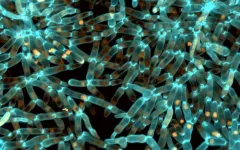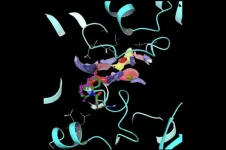(Press-News.org) Researchers have discovered a mechanism steering the evolution of multicellular life. They identified how altered protein folding drives multicellular evolution.
In a new study led by researchers from the University of Helsinki and the Georgia Institute of Technology, scientists turned to a tool called experimental evolution. In the ongoing Multicellularity Long Term Evolution Experiment (MuLTEE), laboratory yeast are evolving novel multicellular functions, enabling researchers to investigate how they arise.
The study puts the spotlight on the regulation of proteins in understanding evolution.
"By demonstrating the effect of protein-level changes in facilitating evolutionary change, this work highlights why knowledge of the genetic code in itself does not provide a full understanding of how organisms acquire adaptive behaviors. Achieving such understanding requires mapping the entire flow of genetic information, extending all the way to the actionable states of proteins that ultimately control the behavior of cells,” says Associate Professor Juha Saarikangas from the Helsinki Institute of Life Science HiLIFE and Faculty of Biological and Environmental Sciences, University of Helsinki.
Snowflake yeast evolves robust bodies in 3,000 generations by changing cell shape
Among the most important multicellular innovations is the origin of robust bodies: over 3,000 generations, these ‘snowflake yeast’ started out weaker than gelatin but evolved to be as strong and tough as wood.
Researchers identified a non-genetic mechanism at the base of this new multicellular trait, which acts at the level of protein folding. The authors found that the expression of the chaperone protein Hsp90, which helps other proteins acquire their functional shape, was gradually turned down as snowflake yeast evolved larger, tougher bodies. It turns out Hsp90 acted as a critically-important tuning knob, destabilizing a central molecule that regulates the progression of the cell cycle, causing cells to become elongated. This elongated shape, in turn, allows cells to wrap around one another, forming larger, more mechanically tough multicellular groups.
"Hsp90 has long been known to stabilize proteins and help them fold properly," explains lead author Kristopher Montrose, from the Helsinki Institute of Life Science, Finland. "What we've found is that slight alterations in how Hsp90 operates can have profound effects not just on single cells, but on the very nature of multicellular organisms."
Path to adaptive evolution through altering protein shapes
From an evolutionary perspective, this work highlights the power of non-genetic mechanisms in rapid evolutionary change.
“We tend to focus on genetic change and were quite surprised to find such large changes in the behavior of chaperone proteins. This underscores how creative and unpredictable evolution can be when finding solutions to new problems, like building a tough body.”, says Professor Will Ratcliff from the Georgia Institute of Technology, USA.
This study was funded by a research grant from the Human Frontier Science Program.
END
New study discovers how altered protein folding drives multicellular evolution
2024-03-08
ELSE PRESS RELEASES FROM THIS DATE:
Socially prescribed creative play boosts parents’ and children’s wellbeing
2024-03-08
University of Leeds news
For immediate release
Socially prescribed creative play boosts parents’ and children’s wellbeing
Socially prescribed creative play helps children and their parents develop new skills and promotes wellbeing, a new study has found.
The University of Leeds-led study evaluated a five-week programme of arts-based play, including singing and music-making, for families of children aged up to three. It found that parents benefited from developing social networks and sharing experiences with each other, as well as learning creative approaches to parenting. ...
Researchers’ approach may protect quantum computers from attacks
2024-03-08
Quantum computers, which can solve several complex problems exponentially faster than classical computers, are expected to improve artificial intelligence (AI) applications deployed in devices like autonomous vehicles; however, just like their predecessors, quantum computers are vulnerable to adversarial attacks.
A team of University of Texas at Dallas researchers and an industry collaborator have developed an approach to give quantum computers an extra layer of protection against such attacks. Their solution, Quantum Noise Injection for Adversarial Defense (QNAD), counteracts the impact of ...
Rogue enzymes cause numerous diseases. A new method could help design drugs to treat them.
2024-03-08
Helicases are enzymes that unwind DNA and RNA. They’re central to cellular life, implicated in a number of cancers and infections—and, alas, extraordinarily difficult to target with drugs.
Now, new research provides a powerful platform for designing covalent inhibitors tailored to target helicases. The paper, published in the Journal of the American Chemical Society, describes how researchers used this innovative new platform to design molecules that take aim at helicases involved in COVID and certain cancers.
“High-resolution structural and biochemical data alone are not sufficient ...
Study shows how oestrogen protects against fatty liver
2024-03-08
New research from Karolinska Institutet in Sweden shows how oestrogen protects against MASLD, a fatty liver disease that has increased dramatically during the current obesity epidemic. The study, published in Molecular Systems Biology, shows how a new drug under development could become a future treatment for fatty liver disease and liver cancer.
The global obesity epidemic has resulted in a dramatic increase in fatty liver, a disease in which fat that does not fit into fat cells is stored in liver cells instead.
Since last year, fatty liver due to obesity (and not excessive alcohol consumption) is known as MASLD (metabolic dysfunction-associated steatotic liver disease). ...
Limited correlation between canine lymphoma and proximity to environmental toxins in new study
2024-03-08
DENVER/March 8, 2024 – As awareness of the health risks associated with radon and fracking exposure in connection to cancer continues to rise in human medicine, a recent study explored these ties with multicentric lymphoma, a prevalent canine cancer. Surprisingly, the study did not identify significant correlations between living near sources of environmental toxins, such as fracking by-products and radon, and dogs diagnosed with lymphoma.
The results of this study were published on Monday using data from Morris Animal Foundation’s Golden Retriever Lifetime Study, which enrolled dogs with multicentric lymphoma and matched unaffected ...
Bald eagles eat prairie dogs? Researchers underscore relationship between raptors and rodents in the southern plains
2024-03-08
We all know that bald eagles like fish. Few of us, however, picture them soaring over grasslands seeking out prairie dog snacks. In a new paper from the Journal of Raptor Research, lead author Courtney Duchardt and coauthors make the case that prairie dogs are an important resource for at least four species of raptors overwintering in the Southern Great Plains, bald eagles included. Their paper, titled “Overwintering Raptor Abundance and Community Composition in Relation to Prairie Dog Colonies in the Southern Great Plains,” explains the first broad scale look into the relationship between prairie dogs and their aerial predators, and illuminates ...
Facing illegal wildlife trade in the European union: A call for comprehensive measures
2024-03-08
New paper now published in Science proposes three measures the European Union should implement to improve open information, legality and sustainability of wildlife trade in the region.
Wildlife trade affects all kinds of species, from insects and fungi to large plants and mammals. The global trade of numerous species poses a significant threat to their survival, increasing their risk of extinction. The European Union is a major global hub for the illegal and unsustainable trade of those species whose international trade is not regulated by the Convention on International Trade in Endangered ...
A better handle on the emissions budget for the Paris climate targets
2024-03-08
A team of scientists from the University of Exeter, Met Office and Imperial College have found a new way to calculate the total carbon emissions consistent with the Paris climate targets of 1.5oC and 2oC of global warming.
Although the exceptionally warm climate in 2023 was close to exceeding the 1.5oC level, the Paris targets relate to the average warming over ten or more years.
The new study answers the question: how much carbon have we got left before we pass the Paris limits?
About 15 years ago, climate scientists discovered a remarkably useful fact about climate change.
Despite the vast complexity ...
High cholesterol was twice as prevalent among American Indian teens and young adults
2024-03-08
Research Highlights:
A study of more than 1,400 people in U.S. tribal communities found that high cholesterol was twice as prevalent among American Indian adolescents and young adults compared to the overall U.S. population.
The study also noted that few study participants with high cholesterol sought or received treatment during the study period.
DALLAS, March 8, 2024 — Young American Indians, ages 15-39, had cholesterol levels more than two times higher than the general U.S. population, according to new research published in the Journal of the American Heart Association, an open access, peer-reviewed journal of the American ...
Good news for coral reef restoration efforts: Study finds “full recovery” of reef growth within four years
2024-03-08
While the majority of the world’s reefs are now under threat or even damaged potentially beyond repair, a new study reported in the journal Current Biology on March 8 offers some encouraging news: efforts to restore coral reefs not only increase coral cover, but they can also bring back important ecosystem functions, and surprisingly fast.
“We found that restored coral reefs can grow at the same speed as healthy coral reefs just four years after coral transplantation,” says Ines Lange (@InesLange9) of University of Exeter, UK. “This means that they provide lots of habitat for ...






